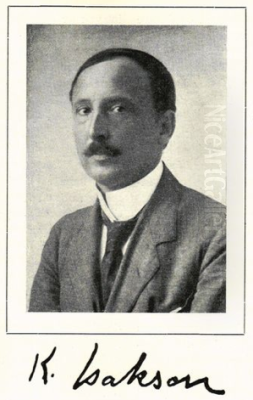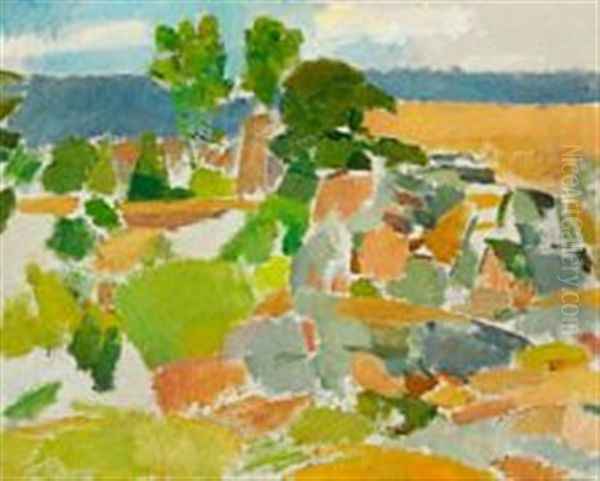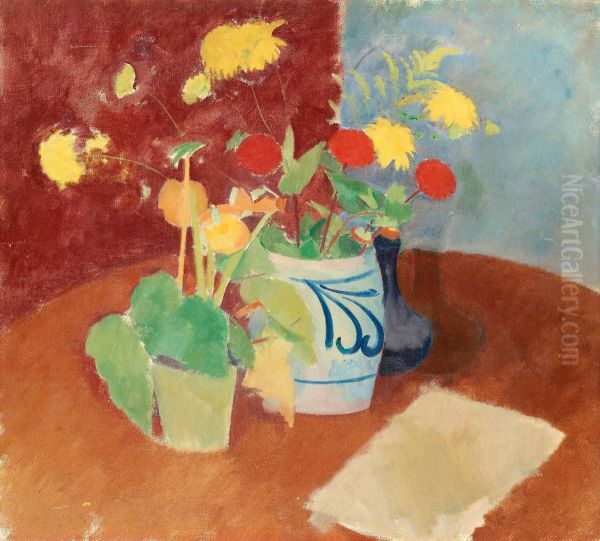
Karl Isakson stands as a significant, albeit sometimes overlooked, figure in the landscape of early 20th-century Scandinavian art. Born in Stockholm, Sweden, on January 16, 1878, and passing away in Copenhagen, Denmark, on February 19, 1922, Isakson's life and career bridged two nations and absorbed the transformative currents of European modern art. Though Swedish by birth, he is widely regarded as one of the foundational artists of Danish Modernism, leaving behind a body of work celebrated for its intense colour, structural integrity, and profound emotional depth. His journey from a challenging childhood to becoming a respected, posthumously acclaimed artist reveals a dedicated and sensitive individual grappling with artistic innovation and personal trials.
Early Life and Artistic Awakening in Stockholm
Isakson's beginnings were marked by hardship. His father, a blacksmith, died when Karl was merely eight months old, leaving his mother to raise him and his sister in relative poverty. This necessitated Isakson leaving formal schooling at the young age of thirteen to contribute to the family income. He worked as a house painter's assistant during the day, but his evenings were dedicated to nurturing his burgeoning artistic talent, attending technical school and drawing classes. This early dedication paid off, eventually leading him to enroll at the prestigious Royal Swedish Academy of Fine Arts in Stockholm (Konstakademien) from 1897 to 1902. Even during his studies, he supported himself by working as a craftsman painter.
His time at the Academy provided him with foundational skills, but Isakson was already seeking more than traditional academic training could offer. He was part of a generation feeling the pull of new artistic ideas emanating from the continent, particularly France. His early experiences instilled in him a strong work ethic and perhaps a certain introspection that would later characterize both his personality and his art.
The Transformative Journey: Italy and Paris

A pivotal moment in Isakson's artistic development occurred in 1902 when he embarked on a study trip abroad, initially heading to Italy. This journey proved crucial not just for the art he encountered but also for the connections he made. In Italy, he met the influential Danish painter Kristian Zahrtmann and his circle of students. Zahrtmann, a significant figure himself, known for his historical paintings and vibrant use of colour, ran a painting school that attracted many young Scandinavian artists eager to break from academic constraints.
It was through Zahrtmann's circle that Isakson was decisively introduced to the revolutionary ideas of French Post-Impressionism, most notably the work of Paul Cézanne. Cézanne's emphasis on underlying structure, his use of colour to build form, and his departure from traditional perspective profoundly impacted Isakson. This encounter marked a turning point, steering him firmly towards Modernism. He began to experiment with colour and form in ways that departed significantly from his earlier training.
Following his time in Italy, Isakson also spent time in Paris around 1905-1907. The French capital was the undisputed centre of the art world, buzzing with innovation. Here, Isakson absorbed the influences of other key figures. He studied the works of the great French colourists and draughtsmen like Edgar Degas and Édouard Manet, appreciating their modern subject matter and bold techniques. He was also drawn to the rich, often mystical, world of Symbolist painter Gustave Moreau, whose influence might be seen in Isakson's later handling of religious and mythological themes. The Parisian milieu further exposed him to Fauvism's daring colour and the nascent stirrings of Cubism, associated with artists like Pablo Picasso and Georges Braque, which would inform his later analytical approach to form.
Denmark, Christiansø, and the Bornholm School
Although Swedish, Isakson spent a significant portion of his adult life and career in Denmark, primarily Copenhagen. In 1911, he made a crucial visit to the small islands of Christiansø, northeast of Bornholm in the Baltic Sea. This location, with its dramatic cliffs, unique light, and relative isolation, became a recurring source of inspiration for him and other artists. His time there solidified his connections with the emerging group of painters often referred to as the Bornholm School or the "Bornholmers."

This group, many of whom had also studied with Kristian Zahrtmann or were similarly inspired by French Modernism, included notable Danish artists like Edvard Weie, Olaf Rude, Kræsten Iversen, and later Oluf Høst. They were drawn to Bornholm and Christiansø for the landscape and the artistic community. Isakson became a central figure among them, sharing their interest in colour, expressive brushwork, and capturing the essence of the landscape rather than merely its surface appearance. His paintings from Christiansø are considered among his finest achievements, demonstrating his mature style.
Isakson's association with Denmark was profound. He felt a strong connection to the Danish art scene and its embrace of modern trends. While he maintained ties to Sweden, his artistic identity became deeply intertwined with his experiences and colleagues in Denmark, contributing significantly to the development of Danish Modernism.
Artistic Style: Colour, Structure, and Emotion
Karl Isakson's art is characterized by its intense focus on colour and form, often exploring a limited range of motifs with cyclical dedication. His main subjects included landscapes (especially from Christiansø), still lifes, figure studies or models, portraits, and later in his life, religious and mythological scenes. His approach was deeply influenced by Paul Cézanne, particularly in his methodical construction of form through planes of colour and his analytical observation of his subjects.
His landscapes, such as the renowned Landscape, Christiansø (also sometimes titled Forest. Christiansø, c. 1915), showcase this approach. They often feature bold, non-naturalistic colours applied with visible brushstrokes, creating a vibrant tapestry that conveys the underlying structure and mood of the scene rather than a photographic likeness. There's a sense of solidity and architectural composition, even in nature, that echoes Cézanne.
In his still lifes, like Still Life With Blue Bowl And Fruits, Isakson demonstrated his mastery as a colourist. He arranged simple objects to explore harmonies and contrasts, focusing on the rhythmic interplay of shapes and hues. His palette could range from intense and vibrant to more subdued and tonal, but always with a remarkable sensitivity to chromatic relationships. Art historians have often described him as one of Scandinavia's most refined colourists, capable of achieving great depth and resonance through his handling of paint.
Later in his career, particularly after experiencing personal difficulties during World War I, Isakson turned increasingly to religious themes, such as the resurrection of Lazarus. These works, often left somewhat unfinished or in a state of exploration at the time of his death, possess a powerful emotional charge and continue his investigation into form and colour, now imbued with spiritual and existential weight. His style, while rooted in French Post-Impressionism, evolved into a distinctly personal and Nordic expression of Modernism, later absorbing influences from artists like Henri Le Fèvre and André Dunoyer de Segonzac which perhaps steered him towards a slightly more restrained, structural form of expression within the modernist idiom.
Representative Works and Thematic Concerns
Several works stand out in Isakson's oeuvre, representing key aspects of his artistic development and thematic interests.
Landscape, Christiansø (c. 1911-1915): This painting, existing in several variations, is perhaps his most iconic. It exemplifies his engagement with the Bornholm landscape and his assimilation of Cézanne's principles. The depiction of the rugged terrain and sparse vegetation is rendered through faceted planes of colour, emphasizing structure and the intense, clear light of the island environment. It's a powerful statement of modern landscape painting in Scandinavia.
Still Life with Blue Bowl and Fruits: Representative of his numerous still lifes, this work highlights Isakson's exceptional colour sense. The composition is carefully balanced, with the objects serving as vehicles for exploring formal relationships and colour harmonies. The "musicality" often attributed to his colour compositions is evident here, where hues resonate against each other with quiet intensity.
Jesus Awakens Lazarus (c. 1918-1921): Part of a series of religious paintings undertaken in his later years, this work tackles a profound theme of death and resurrection. Likely painted after his recovery from a wartime breakdown, it reflects a deep personal and spiritual exploration. While sometimes described as unfinished, its expressive power and bold simplification of forms demonstrate Isakson's continued artistic searching. (Note: Some sources erroneously list a much later completion date, likely referring to exhibition or rediscovery; the work originates from the final years of his life).
Gudhems visa (View from Gudhem): While less universally known than the Christiansø landscapes, this title suggests another landscape subject, likely reflecting his continued interest in capturing specific locations through his modernist lens. His landscapes often focused on the interplay between nature and structure, whether natural rock formations or man-made elements.
These works, alongside numerous portraits and model studies, reveal an artist constantly experimenting within his chosen framework, seeking to penetrate the surface reality of his subjects to reveal deeper truths through colour and form.
Personal Struggles, Exhibition Reluctance, and Posthumous Recognition
Isakson's life was not without its difficulties. Beyond his impoverished childhood, he suffered from periods of poor health and psychological distress. During World War I, he experienced a nervous breakdown that temporarily halted his ability to paint. It was after this period that he turned more intensely to religious subjects, perhaps seeking solace or exploring themes of suffering and redemption.
A notable aspect of Isakson's career was his reluctance to exhibit his work. Despite achieving some recognition early on, possibly around 1910, he reportedly developed doubts about his own achievements and largely withdrew from the exhibition circuit. This self-imposed isolation meant that his work was not widely known or appreciated by the broader public during his lifetime. He preferred to work intensely and privately, constantly reworking canvases in his quest for artistic truth.
His premature death in Copenhagen in 1922 at the age of 44 cut short a career that was still evolving. However, a large memorial exhibition held that same year finally brought the full scope and quality of his work to light. This posthumous exhibition was a revelation for many and secured his reputation as a major figure in Scandinavian Modernism. Decades later, exhibitions like one reportedly held at the Volvo premises in Stockholm in 1972, and ongoing displays in major museums, continued to affirm his importance.
Interactions and Influence: A Network of Artists
Karl Isakson did not work in a vacuum. His artistic journey was shaped by encounters and dialogues, both direct and indirect, with numerous other artists. His relationship with Kristian Zahrtmann was foundational, providing not only mentorship but also a crucial link to continental European trends and a community of like-minded Danish artists.
The influence of Paul Cézanne is undeniable and perhaps the most significant stylistic imprint on Isakson's work. He absorbed Cézanne's lessons on structure, colour modulation, and the analytical observation of nature. In Paris, the exposure to Edgar Degas, Édouard Manet, and Gustave Moreau broadened his technical and thematic horizons, exposing him to Impressionist and Symbolist currents. The ambient influence of Fauvism and early Cubism, through figures like Henri Matisse (a fellow student of Moreau for a time), Pablo Picasso, and Georges Braque, also informed his increasingly modern approach.
His association with the Bornholm School placed him in direct contact with Danish contemporaries like Edvard Weie, Olaf Rude, and Kræsten Iversen. They shared a common ground in their exploration of colour and landscape, inspired by both French models and the unique environment of Bornholm. While Isakson maintained a distinct voice, the shared artistic concerns and geographical focus created a fertile ground for mutual exchange.
Later influences mentioned, such as Henri Le Fèvre and André Dunoyer de Segonzac, suggest his continued engagement with French art, perhaps leaning towards a more restrained or classically-inflected form of Modernism in his final years, though his core remained deeply rooted in the colourist and structural lessons learned earlier. His legacy, in turn, influenced subsequent generations of Scandinavian artists who grappled with the heritage of Modernism.
Art Historical Significance and Legacy
Karl Isakson holds a secure place in Scandinavian art history, primarily as a pioneer of Modernism, particularly in the Danish context despite his Swedish origins. His key contribution lies in his synthesis of French Post-Impressionist ideas, especially Cézanne's, with a unique Nordic sensibility. He demonstrated how the revolutionary principles of modern art could be applied to Scandinavian subjects and landscapes, paving the way for others.
His reputation rests heavily on his exceptional abilities as a colourist. Critics and historians consistently praise his sophisticated understanding of colour harmony, his ability to use colour structurally, and the deep emotional resonance he achieved through his palette. He treated colour not merely as description but as the primary means of expression and construction within his paintings.
The "controversy" surrounding Isakson pertains more to his personality and career choices – his self-doubt, his withdrawal from exhibitions – rather than significant debate about the quality or importance of his art itself. While his reluctance to exhibit delayed wider recognition, the intrinsic quality of his work ensured its eventual acclaim. His relatively small, intensely worked oeuvre is now seen as a cornerstone of early 20th-century Scandinavian painting.
Today, Karl Isakson's works are held in major public collections, including the Statens Museum for Kunst (National Gallery of Denmark) in Copenhagen and the Bornholm Art Museum, ensuring his legacy is accessible to new generations. He is remembered as a dedicated, sensitive, and innovative artist whose work bridges Swedish and Danish art histories and stands as a powerful testament to the transformative power of colour and form in the modern era.
Conclusion: A Bridge Between Nations and Styles
Karl Isakson's artistic journey was one of intense searching and synthesis. From his challenging start in Stockholm to his pivotal encounters in Italy and Paris, and his deep engagement with the Danish art scene and the landscapes of Bornholm, he forged a unique artistic identity. He absorbed the lessons of European masters like Cézanne, Degas, and Moreau, integrating them into a vision that remained distinctly personal and deeply felt. As a key figure in the Bornholm School and a foundational force in Danish Modernism, his legacy endures through his powerful, colour-rich paintings that continue to resonate with viewers today. He stands as a vital link, a bridge connecting Swedish roots, Danish artistic community, and the broader currents of international Modernism.